The NVIDIA Turing GPU Architecture Deep Dive: Prelude to GeForce RTX
by Nate Oh on September 14, 2018 12:30 PM ESTThe Turing Trio: TU102, TU104, & TU106
Altogether, NVIDIA will be kicking off the Turing generation with a trio of GPUs: TU102, TU104, and TU106. Notably, this is a much larger product stack than any past NVIDIA consumer launch. Typically NVIDIA releases just a single GPU on launch day – usually the 104 model – and then additional GPUs filter in months down the line as production ramps up. Instead NVIDIA will be releasing products based on two different GPUs this month, and then following that up with a third GPU one month later.
Since all three GPUs are Turing, all three GPUs share the same basic design, and in the same ratios. Meaning that TU104 and TU106 are proportionally cut-down versions of TU102, without any radical changes between the GPUs like we’ve seen between GP100 and GP102/104/106. This also means that TU104 and TU106 are proportionally powerful GPUs; NVIDIA hasn’t stripped TU106’s RT and tensor cores to a bare minimum to save on the transistor count, for example.
| NVIDIA Turing GPU Comparison | ||||||
| TU102 | TU104 | TU106 | GP102 | |||
| CUDA Cores | 4608 | 3072 | 2304 | 3840 | ||
| SMs | 72 | 48 | 36 | 30 | ||
| Texture Units | 288 | 192 | 144 | 240 | ||
| RT Cores | 72 | 48 | 36 | N/A | ||
| Tensor Cores | 576 | 384 | 288 | N/A | ||
| ROPs | 96 | 64 | 64 | 96 | ||
| Memory Bus Width | 384-bit | 256-bit | 256-bit | 384-bit | ||
| L2 Cache | 6MB | 4MB | 4MB | 3MB | ||
| Register File (Total) | 18MB | 12MB | 9MB | 7.5MB | ||
| Architecture | Turing | Turing | Turing | Pascal | ||
| Manufacturing Process | TSMC 12nm "FFN" | TSMC 12nm "FFN" | TSMC 12nm "FFN" | TSMC 16nm | ||
| Die Size | 754mm2 | 545mm2 | 445mm2 | 471mm2 | ||
The flagship for the Turing family is a part that we’ve quickly become familiar with, and that is TU102. The largest of the Turing GPUs, this is the GPU NVIDIA is tapping for two of their new Quadro RTX cards, as well as the GeForce RTX 2080 Ti.
A fully-enabled TU102 is comprised of 72 SMs, organized into 6 GPCs. And since the number of RT cores and tensor cores is proportional to the SM count, we’re looking at 72 RT cores and 576 tensor cores. Paired with this harder is 12 ROP/memory controller partitions, giving the GPU a native 384-bit memory bus and 96 ROPs for pixel blending.
Relative to NVIDIA’s GV100 GPU, TU102 is smaller and contains fewer SM and tensor cores, but the difference is not quite as great as you might think. The 18.6B transistor, 754mm2 chip still packs 85% of GV100’s common hardware even with its physically small size, and then this value doesn’t include all the die space taking up by Turing’s new features such as the RT cores and the newer generation tensor cores. So this is still an incredibly big chip, and is especially notable since NVIDIA will be putting it in a consumer card.
Outside of the standard Turing graphics hardware, of particular note here is that because TU102 pulls double-duty with high-end Quadro cards, it’s the only GPU to feature two NVLink connections. Each NVLink connection – which NVIDIA technically classifies as an 8x NVlink – is capable of offering 25GB/sec of bandwidth in each direction, for a total of 50GB/sec of bandwidth in each direction when the links are used in aggregate.
The middle child of the stack and the traditional frontrunner in NVIDIA’s GPU release cadence is the TU104. This part is a smaller, slimmer Turing GPU that shaves off some SMs in the name of coming in at a smaller die size. Altogether it offers 48 SMs and 8 ROP/MC partitions, making it roughly two-thirds of a TP102.
In exchange the chip is also notably smaller. Not small by any means, but smaller. The part comes in at 13.6B transistors, which are laid out in a 545mm2 die. This still makes it the largest x04 chip by a landslide, coming in much larger than even the late-generation 28nm GM204 in 2014. Still, NVIDIA shaved off over 200mm2 relative to TU102, so there are significant die savings here compared to using an actual cut-down TU102.
The TU104 will be going into just one consumer card, at least for now. This is the GeForce RTX 2080. It will also be going into its Quadro counterpart, the Quadro RTX 5000. Notably, only the Quadro is getting a fully enabled chip, while RTX 2080 ships with a couple of disabled SMs. This GPU also features NVLink support, but this time it’s a single x8 link, half of what TU102 offered.
Finally, rounding out the trio is the mysterious TU106 GPU, which prior to today had not been disclosed by NVIDIA. Rather than using a cut-down TU104 in the GeForce RTX 2070, they’re going to use an entirely different GPU.
TU106 in turn is a smaller chip than TU104, but perhaps not as much as you think. NVIDIA is still including 36 SMs and the same 8 ROP/MC partitions, so in terms of pixel throughput and bandwidth TU106 is actually identical to TU104 on paper. It’s only when looking at the processor elements that we see that we’ve ended up with what’s essentially 75% of a TU104. On which note however, it’s rather interesting that NVIDIA opted to halve the GPC count here; TU106 packs 12 SMs to a GPC, versus 8 to a GPC in TU104.
The payoff for NVIDIA here is that TU106 once again brings down NVIDIA’s large die sizes. The chip features 10.8 billion transistors, which at 445mm2 still makes it a beefy chip. But this is at least finally smaller than the GP102 used in the Pascal Titan Xp cards.
The net result of all of this is that NVIDIA has a very interesting GPU launch stack, one unlike anything we’ve seen before. No two GeForce cards share the same GPU; there is a GPU for each and every card right now. And we’re seeing NVIDIA launch two GPUs right out the door, including the massive TU102, with the TU106 to follow close behind. So it’s a very different setup than the norm for NVIDIA.
Turing In Practice: GeForce RTX 2080 Ti, 2080, & 2070
These 3 GPUs, in turn, form the foundation of the GeForce RTX 2080 Ti, RTX 2080, and RTX 2070. As previously announced by NVIDIA, the first two cards will go on sale next week, on September 20th. Meanwhile the RTX 2070 will ship a bit later, with sales starting in October.
We’ll be giving the RTX 2080 Ti and RTX 2080 a full work-through next week in our review of those cards. In the meantime, here’s a recap of their specifications and pricing.
| NVIDIA GeForce x80 Ti Specification Comparison | ||||||
| RTX 2080 Ti Founder's Edition |
RTX 2080 Ti | GTX 1080 Ti | GTX 980 Ti | |||
| CUDA Cores | 4352 | 4352 | 3584 | 2816 | ||
| ROPs | 88 | 88 | 88 | 96 | ||
| Core Clock | 1350MHz | 1350MHz | 1481MHz | 1000MHz | ||
| Boost Clock | 1635MHz | 1545MHz | 1582MHz | 1075MHz | ||
| Memory Clock | 14Gbps GDDR6 | 14Gbps GDDR6 | 11Gbps GDDR5X | 7Gbps GDDR5 | ||
| Memory Bus Width | 352-bit | 352-bit | 352-bit | 384-bit | ||
| VRAM | 11GB | 11GB | 11GB | 6GB | ||
| Single Precision Perf. | 14.2 TFLOPs | 13.4 TFLOPs | 11.3 TFLOPs | 6.1 TFLOPs | ||
| "RTX-OPS" | 78T | 78T | N/A | N/A | ||
| TDP | 260W | 250W | 250W | 250W | ||
| GPU | TU102 | TU102 | GP102 | GM200 | ||
| Architecture | Turing | Turing | Pascal | Maxwell | ||
| Manufacturing Process | TSMC 12nm "FFN" | TSMC 12nm "FFN" | TSMC 16nm | TSMC 28nm | ||
| Launch Date | 09/20/2018 | 09/20/2018 | 03/10/2017 | 06/01/2015 | ||
| Launch Price | $1199 | $999 | MSRP: $699 Founders: $699 |
$649 | ||
The king of NVIDIA’s new product stack, the GeForce RTX 2080 Ti is without a doubt an interesting card. NVIDIA’s consumer flagship sports 4352 Turing CUDA cores and 544 tensor cores, as well as 68 RT cores. Like its Quadro counterpart, this card is rated for 10 GigaRays/second, and for traditional compute we’re looking at 13.4 TFLOPS based on these specifications. Note that on paper this is only 19% higher than GTX 1080 Ti, which is why NVIDIA’s architectural changes and efficiency improvements are going to carry the day here, rather than brute forcing the matter with more hardware.
Clockspeeds have actually dropped from generation to generation here. Whereas the GTX 1080 Ti started at 1.48GHz and had an official boost clock rating of 1.58GHz (and in practice boosting higher still), RTX 2080 Ti starts at 1.35GHz and boosts to 1.55GHz, while we don’t know anything about the practical boost limits. So assuming NVIDIA is being as equally conservative as the last generation, then this means the average clockspeeds have dropped slightly.
Moving on, for the ROP and memory subsystem we’re looking at a partially-enabled configuration here as well. RTX 2080 Ti offers 88 of 96 ROPs, which is a result of NVIDIA disabling one of the 12 ROP/MC partitions. Even then, relative to the GTX 1080 Ti and thanks to GDDR6, memory clockspeeds have been boosted from 11Gbps to 14Gbps, a 27% increase. And since the memory bus width itself remains identical at 352-bits wide, this means the final memory bandwidth increase is also 27%.
Past this, things start diverging a bit. NVIDIA is once again offering their reference-grade Founders Edition cards, and unlike with the GeForce 10 series, the 20 series FE cards have slightly different specifications than their base specification compatriots. Specifically, NVIDIA has cranked up the clockspeed and the resulting TDP a bit, giving the 2080 Ti FE an on-paper 6% performance advantage, and also a 10W higher TDP. For the standard cards then, the TDP is the x80 Ti-traditional 250W, while the FE card moves to 260W.
| NVIDIA GeForce x80 Specification Comparison | ||||||
| RTX 2080 Founder's Edition |
RTX 2080 | GTX 1080 | GTX 980 | |||
| CUDA Cores | 2944 | 2944 | 2560 | 2048 | ||
| ROPs | 64 | 64 | 64 | 64 | ||
| Core Clock | 1515MHz | 1515MHz | 1607MHz | 1126MHz | ||
| Boost Clock | 1800MHz | 1710MHz | 1733MHz | 1216MHz | ||
| Memory Clock | 14Gbps GDDR6 | 14Gbps GDDR6 | 10Gbps GDDR5X | 7Gbps GDDR5 | ||
| Memory Bus Width | 256-bit | 256-bit | 256-bit | 256-bit | ||
| VRAM | 8GB | 8GB | 8GB | 4GB | ||
| Single Precision Perf. | 10.6 TFLOPs | 10.1 TFLOPs | 8.9 TFLOPs | 5.0 TFLOPs | ||
| "RTX-OPS" | 60T | 60T | N/A | N/A | ||
| TDP | 225W | 215W | 180W | 165W | ||
| GPU | TU104 | TU104 | GP104 | GM204 | ||
| Architecture | Turing | Turing | Pascal | Maxwell | ||
| Manufacturing Process | TSMC 12nm "FFN" | TSMC 12nm "FFN" | TSMC 16nm | TSMC 28nm | ||
| Launch Date | 09/20/2018 | 09/20/2018 | 05/27/2016 | 09/18/2014 | ||
| Launch Price | $799 | $699 | MSRP: $599 Founders $699 |
$549 | ||
Moving down the line, we have the GeForce RTX 2080. Based on TU104, this card offers 2944 CUDA cores paired with 368 tensor cores. Like the RTX 1080 Ti, clockspeeds have dropped a bit from generation to generation, as the base clock is down to 1515MHz and the boost clock to 1710MHz. All told we’re looking at a pure CUDA core compute throughput of 10.1 TFLOPs, about 13% higher than the GTX 1080. Or if we compare it to the RTX 2080 Ti, we’d see around 75% of the expected compute/tensor performance, which is only a bit larger than the jump we saw between the GTX 1080 and GTX 1080 Ti.
Meanwhile the card does come with a fully enabled memory bus, meaning we’re looking at 8GB of GDDR6 running at 14Gbps, on top of a 256-bit memory bus. Relative to the GTX 1080 this is an even more significant 40% increase in memory bandwidth.
As for TDPs, they’ve gone up for this band of cards. The stock RTX 2080 will have a 215W TDP, up 30W from the GTX 1080’s 180W TDP, and an even bigger increase if we look at GTX 980’s 165W TDP. It’s no secret that NVIDIA is fighting a losing battle with Moore’s Law here, and barring massive efficiency improvements, there is a need to increase TDPs to keep up overall performance. TU104 is a big chip, and without a full node shrink, it would seem that NVIDIA has to pay a power penalty instead. In the meantime this higher TDP also negates some of the RTX 2080 Ti’s power disadvantage, as now that gap is just 35W instead of 65W.
| NVIDIA GeForce x70 Specification Comparison | ||||||
| RTX 2070 Founder's Edition |
RTX 2070 | GTX 1070 | GTX 970 | |||
| CUDA Cores | 2304 | 2304 | 1920 | 1664 | ||
| ROPs | 64 | 64 | 64 | 64 | ||
| Core Clock | 1410MHz | 1410MHz | 1506MHz | 1050MHz | ||
| Boost Clock | 1710MHz | 1620MHz | 1683MHz | 1178MHz | ||
| Memory Clock | 14Gbps GDDR6 | 14Gbps GDDR6 | 8Gbps GDDR5 | 7Gbps GDDR5 | ||
| Memory Bus Width | 256-bit | 256-bit | 256-bit | 256-bit | ||
| VRAM | 8GB | 8GB | 8GB | 4GB | ||
| Single Precision Perf. | 7.9 TFLOPs | 7.5 TFLOPs | 6.5 TFLOPs | 3.9 TFLOPs | ||
| "RTX-OPS" | 45T | 45T | N/A | N/A | ||
| TDP | 185W | 175W | 150W | 145W | ||
| GPU | TU106 | TU106 | GP104 | GM204 | ||
| Architecture | Turing | Turing | Pascal | Maxwell | ||
| Manufacturing Process | TSMC 12nm "FFN" | TSMC 12nm "FFN" | TSMC 16nm | TSMC 28nm | ||
| Launch Date | 09/20/2018 | 09/20/2018 | 06/10/2016 | 09/18/2014 | ||
| Launch Price | $599 | $499 | MSRP: $379 Founders $449 |
$329 | ||
The final member of the new GeForce RTX family is the GeForce RTX 2070. Traditional for its roots, this is the “value” enthusiast card, giving up some of the RTX 2080’s performance in exchange for a lower price. Though with prices starting at $499, “value” and “cheap” are not the same thing.
With TU106, NVIDIA has shaved off a number of SMs. The end result is that the RTX 2070 offers 2304 CUDA cores and 288 tensor cores. Meanwhile ray tracing performance is rated at 6 GigaRays/second. Meanwhile in an interesting twist, this is the only consumer part launching with a fully-enabled GPU: TU106 offers 36 SMs, and NVIDIA is using all 36 of them.
Like the other RTX cards, clockspeeds have dropped a bit versus the previous generation; the base clock now starts at 1410MHz, and the boost clock is 1620MHz. On paper then, compute throughput works out to 7.5 TFLOPs, up 15% from GTX 1070. Or if we compare it to the 2080, the 2070 should deliver around 75% of its bigger sibling’s compute performance, which makes the jumps between the 2070, 2080, and 2080 Ti all very symmetrical. This is also an ever so slightly smaller gap than what was between the GTX 1080 and GTX 1070.
Also like the RTX 2080, this appears to be a fully enabled memory configuration. Meaning we’re looking at 8GB of GDDR6 running at 14Gbps, on top of a 256-bit memory bus. Relative to the GTX 1070 this is the single greatest bandwidth increase of all of the RTX cards; the 2070 will enjoy a 75% increase in memory bandwidth over its Pascal predecessor, as the GTX 1070 never did use GDDR5X.
TDPs have gone up here as well. The RTX 2070 is rated for 175W, up from 150W for the GTX 1070, and 145W for the GTX 970. As with the RTX 2080, it looks like NVIDIA is paying for their performance and new features via higher power consumption in lieu of a full node shrink.


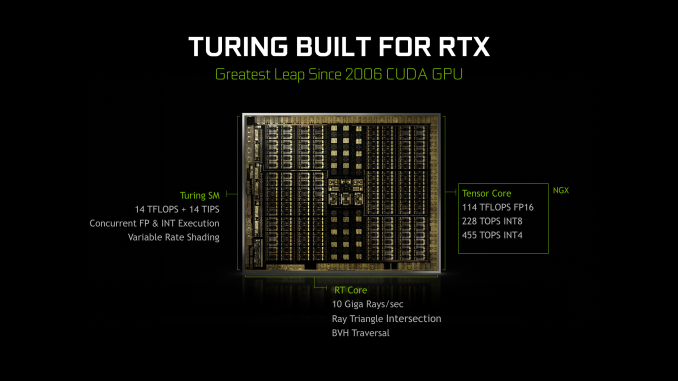

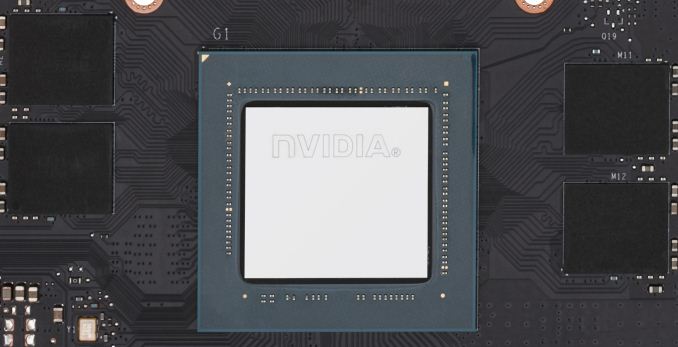
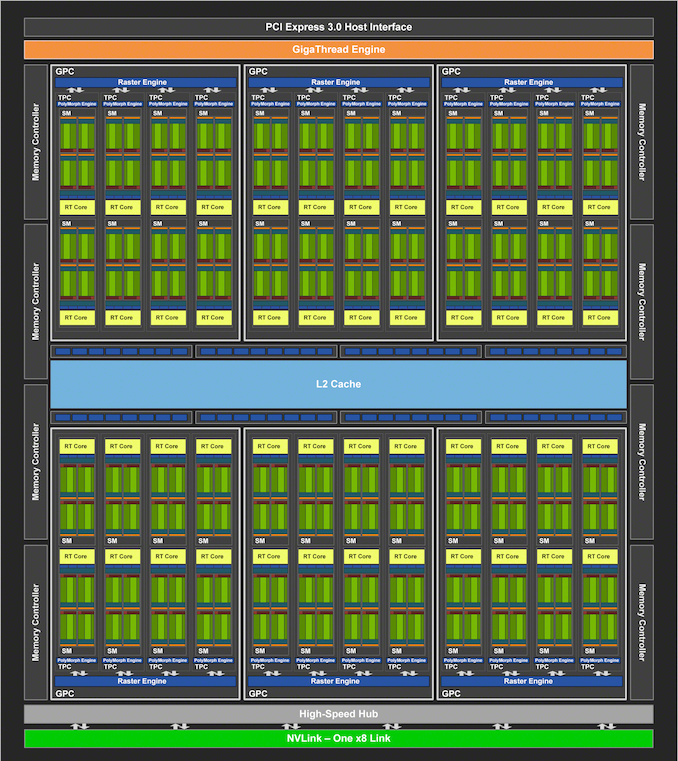

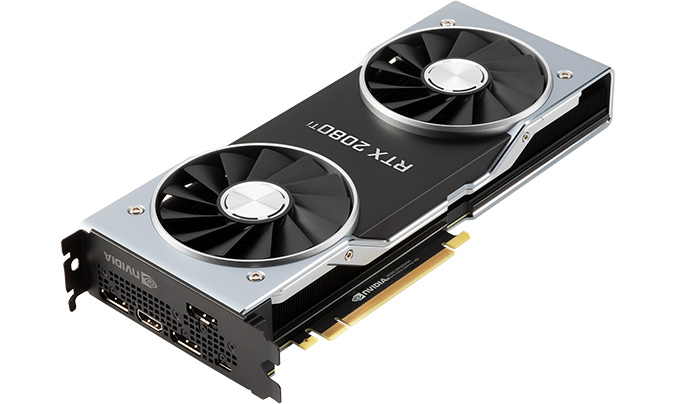
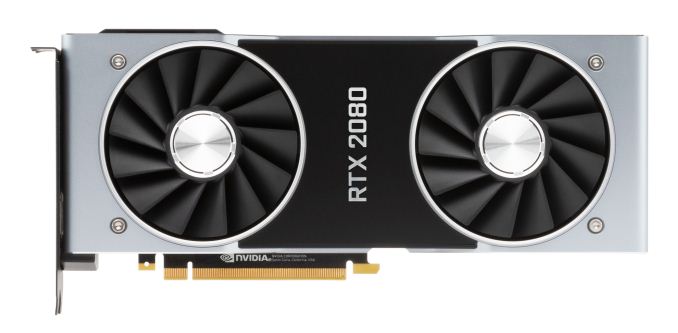
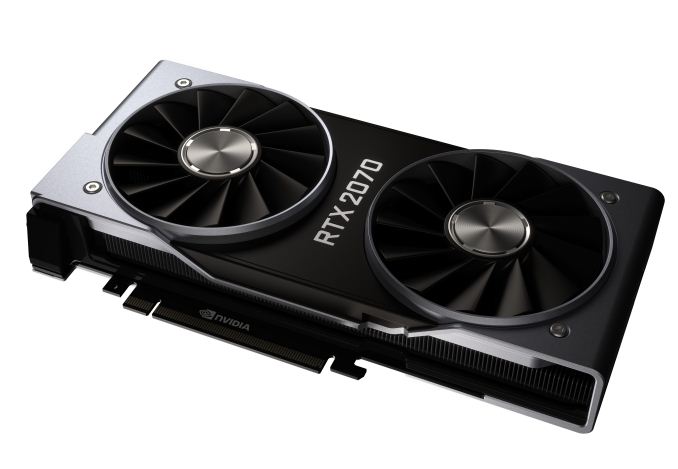








111 Comments
View All Comments
xXx][Zenith - Friday, September 14, 2018 - link
Nice write-up! With 25% of the chip area dedicated to Tensor Cores and other 25% to RT Cores NVIDIA is betting big on DLSS and RTX for gaming usecases. With all the architectural improvements, better memory compression ... AMD is out of the game, quite frankly.Btw, for the fans of GigaRays/Sec, aka CEO metric, here is a Optix-RTX benchmark for Volta, Pascal and Maxwell GPUs: https://www.youtube.com/watch?v=ULtXYzjGogg
OptiX 5.1 API will work with Turing GPUs but will not take advantage of the new RT Cores, so older-gen NV GPUs can be directly compared to Turing. Application devs need to rebuild with Optix 5.2 to get access to HW accelarated ray tracing. Imho, RTX cards will have nice speedup with Turing RT Cores using GPU renderers (Octane, VRay, ...) but the available RAM will limit the scene complexity big time.
blode - Friday, September 14, 2018 - link
hate when i lose a game before my opponent arriveseddman - Friday, September 14, 2018 - link
As far as I can tell, GigaRays/Sec is not an nvidia made term. It's been used before by others too, like imagination tech.The nvidia made up term is RTX-ops.
xXx][Zenith - Friday, September 14, 2018 - link
Ray tracing metric without scene complexity, viewport placement is just smoke and mirrors ...From whitepaper: "Turing ray tracing performance with RT Cores is significantly faster than ray tracing in Pascal GPUs. Turing can deliver far more Giga Rays/Sec than Pascal on different workloads, as shown in Figure 19. Pascal is spending approximately 1.1 Giga Rays/Sec, or 10 TFLOPS / Giga Ray to do ray tracing in software, whereas Turing can do 10+ Giga Rays/Sec using RT Cores, and run ray tracing 10 times faster."
eddman - Saturday, September 15, 2018 - link
I don't know the technical details of ray tracing, but how is that nvidia statement related to scene complexity, etc?From my understanding of that statement, they are simply saying that turing is able to deliver far more rays/sec than pascal, because it is basically hardware-accelerating the operations through RT cores but pascal has to do all those operations in software through regular shader cores.
niva - Wednesday, September 19, 2018 - link
If you hold scene complexity constant (take the same environment/angle) and run a ray tracing experiment, the new hardware will be that much faster at cranking out frames. At least that's how I'm interpreting the article and the statement above, I'm not really sure if that's accurate though...Yojimbo - Saturday, September 15, 2018 - link
When did Imgtec use gigarays? As far as I remember they didn't have hardware capable of a gigaray. They measured in hundreds of millions of rays per second, and I don't remember them using the term "megaray", either. Just something along the lines of "200 million rays/sec".eddman - Saturday, September 15, 2018 - link
Why fixate on the "giga" part? I obviously meant rays/sec; forgot top remove the giga part after copy/paste. A measuring method doesn't change with quantity.Yojimbo - Saturday, September 15, 2018 - link
Because the prefix is the whole point. The point is the terminology, not the measuring method. Rays per second is pretty obvious and has probably been around since the 70s. The "CEO metric" the OP was talking about was specifically about "gigarays per second". Jensen Huang said it during his SIGGRAPH presentation. Something like "Here's something you probably haven't heard before. Gigarays. We have gigarays."eddman - Saturday, September 15, 2018 - link
What are you on about? He meant "giga" as in "billion". It's so simple. He said it that way to make it sound impressive.